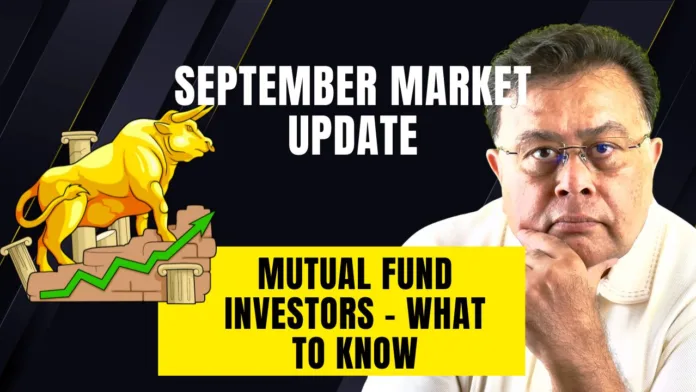Opening Story: My Day at the Market Update Meet
Today, I attended an in-depth market and economy update session with a leading fund manager. Sitting in a room full of analysts and fellow advisors, I took notes that can help you, the everyday investor, understand what’s going on behind all the numbers. This article distils that experience into clear takeaways you can act on.
1. Indian Economy – Strong Foundations, Brighter Prospects
The presentation began with a simple truth: India’s macro story remains robust.
• Government Stability: A politically stable environment has allowed for consistent fiscal policy.
• Fiscal Health: Government finances are under control; deficit targets are on track.
• Corporate Cycles: Businesses are in good shape thanks to policy continuity and steady demand.
The result? Despite market noise, our economy continues to move forward like a well-oiled train.
2. Commodities and Real Estate – Signs of Confidence
Commodities and real estate prices are rising, reflecting demand and investor appetite. For many Indian households, real estate remains an emotional and financial anchor. But what’s changing is that more households are also investing in equities and mutual funds, creating a healthier balance of assets.
3. Household Shift – From Gold and Property to Mutual Funds
Traditionally, Indian households parked savings in gold and real estate. Now, thanks to better financial literacy and digital platforms, crores of Indians invest monthly via SIPs. This steady inflow gives our markets a cushion even when foreign investors pull out.
It’s a sign of India’s transition from an under-developed to a developing (and eventually developed) economy: more capital flowing into productive assets like equities.
4. RBI and Interest Rates – A Supportive Stance
The RBI’s leadership change has brought a softer tone on rates. We may even see rate cuts in the next 3–6 months to support growth. Lower interest rates help businesses borrow more affordably, fuel consumption, and boost corporate profits—all positive signals for equity investors.
5. Cyclical Slowdown – Short-Term Blips, Long-Term Opportunity
Yes, some cyclical sectors are seeing slower growth. Tight government policies in 2024 are still playing out, and their impact will show over the next 18 months. But this is part of any healthy economy. With consumer spending recovering and corporate balance sheets stronger, the longer-term trajectory remains up.
6. Global Context – Winds We Must Sail With
India doesn’t operate in a vacuum.
• Rising US rates or a slowdown in Europe can cause foreign investors to withdraw temporarily.
• Commodity price swings ripple into our inflation numbers.
• China’s post-COVID growth spurt also shapes regional demand.
However, India’s domestic growth engine is running hot enough to counter many of these shocks.
7. Valuations – A Window of Opportunity
The latest Nifty P/E is 22.01 (FY25 actual), 21.37 (FY26E) and 20.42X forward. While headline returns have been muted recently, valuations still signal that opportunities exist for long-term investors—especially those using disciplined SIPs to accumulate units.
8. Why Stay Invested – The Power of Diversified Equity Mutual Funds
When markets wobble, many investors feel like jumping ship. But history shows staying invested works best:
• You buy more units during market dips.
• Diversification across sectors cushions shocks.
• The India growth story plays out over years, not days.
Diversified equity mutual funds—flexi-cap, multi-cap, and large-and-mid-cap—let you participate in this growth without guessing which sector will win.
9. Which Categories of Mutual Funds Make Sense Today
Based on the current environment, here’s what to consider for long-term investing (purely educational):
• Flexi-Cap Funds: Move across large, mid, and small caps as conditions change.
• Multi-Cap Funds: Broader allocation to capture sectoral shifts.
• Large & Mid Cap Funds: A blend of stability and growth.
• Index Funds: Low-cost, steady compounding for disciplined investors.
• Hybrid & Aggressive Hybrid Funds: For investors wanting a cushion of debt with equity upside.
• Gold Funds / Sovereign Gold Bonds: 10–15% allocation for risk balancing.
Always align categories to your time horizon and risk profile. For a 10+ year horizon, equity-heavy funds shine; for shorter horizons, hybrid or debt funds fit better.
10. Putting It All Together – India’s Transition Story
Just like China saw rapid growth after COVID, India is entering a phase where manufacturing, services, and household investment patterns are all aligning. Fiscal prudence, RBI’s supportive stance, and household savings moving into equity markets—these three structural factors create a strong foundation for wealth creation.
11. Three Takeaways for You
- Think Long-Term: India’s growth story is intact; short-term blips are normal.
- Stay Diversified: Flexi-cap, multi-cap, and index funds help you weather cycles.
- Use SIPs as Your Friend: Keep investing regularly to average costs and build wealth.
12. My Anecdote – Learning Patience at a Fund Manager’s Table
At today’s meet, a senior fund manager said something I loved: “The Indian economy is like a mango tree. You can’t rush it. But every season you water it, and the fruit gets sweeter.”
That’s exactly how I see our mutual fund SIPs—patient watering brings eventual abundance.
13. The Bottom Line
India’s macro fundamentals are strong, global factors are manageable, and diversified mutual funds remain the simplest, most effective way to participate in long-term growth. Focus on your financial goals, not market headlines.
CTA:
Want to review your portfolio in light of these trends? Book a call with me at https://tinyurl.com/Video-tb.
Disclaimer: The views expressed are for educational purposes only and do not constitute financial, investment, tax, or legal advice. Please consult qualified professionals before making decisions. Mutual fund investments are subject to market risks.
👉 Full Disclaimer | Disclosures | Terms of Use
| 👉Join my FAN page at: | facebook.com/CFPTareshBhatia |
| 👉Follow on Facebook: | facebook.com/TareshBhatiaCFPro |
| 👉Follow me on Instagram: | instagram.com/tareshbhatiacfp |
| 👉Follow me on Threads: | threads.net/@tareshbhatiacfp |
| 👉Follow me on Twitter: | twitter.com/tareshbhatiacfp |
| 👉Follow me on LinkedIn: | linkedin.com/in/tareshbhatiacfp |
| 👉Visit Website: | tareshbhatia.com |
| 👉Read Blog: | blog.tareshbhatia.com |
| 👉Buy my Book: | pages.razorpay.com/BookTRP |
| 👉Join me on Telegram: | t.me/+v0ewUJQU0wowN2Jl |
| 👉YouTube Channel: | youtube.com/@Taresh-Bhatia |
| 👉Subscribe: | tinyurl.com/SubscTB |
| 👉Join my Academy: | therichnessacademy.com |
| 👉Complimentary Session-Limited Offer: | learn.therichnessacademy.com/web/checkout/686f9d1203ac6c6374689439 |
| 👉WhatsApp message directly: | wa.me/919810127906 |
| 👉Get Ebook: | tinyurl.com/TenEbook |
The author of this article, Taresh Bhatia, is a Certified Financial Planner® and advocate for female empowerment. For more information and personalized financial guidance, please contact taresh@tareshbhatia.com
He has authored an Amazon best seller-“The Richness Principles”. He is the Coach and founder of The Richness Academy, an online coaching courses forum. This article serves educational purposes only and does not constitute financial advice. Consultation with a qualified financial professional is recommended before making any investment decisions. An educational purpose article only and not any advice whatsoever.
©️2025: All Rights Reserved. Taresh Bhatia. Certified Financial Planner®
Subscribe Now for Upcoming Blogs!
[convertkit form=6555951]
📢 Join free live webinar —
Couple Finance Formula™ Register here




